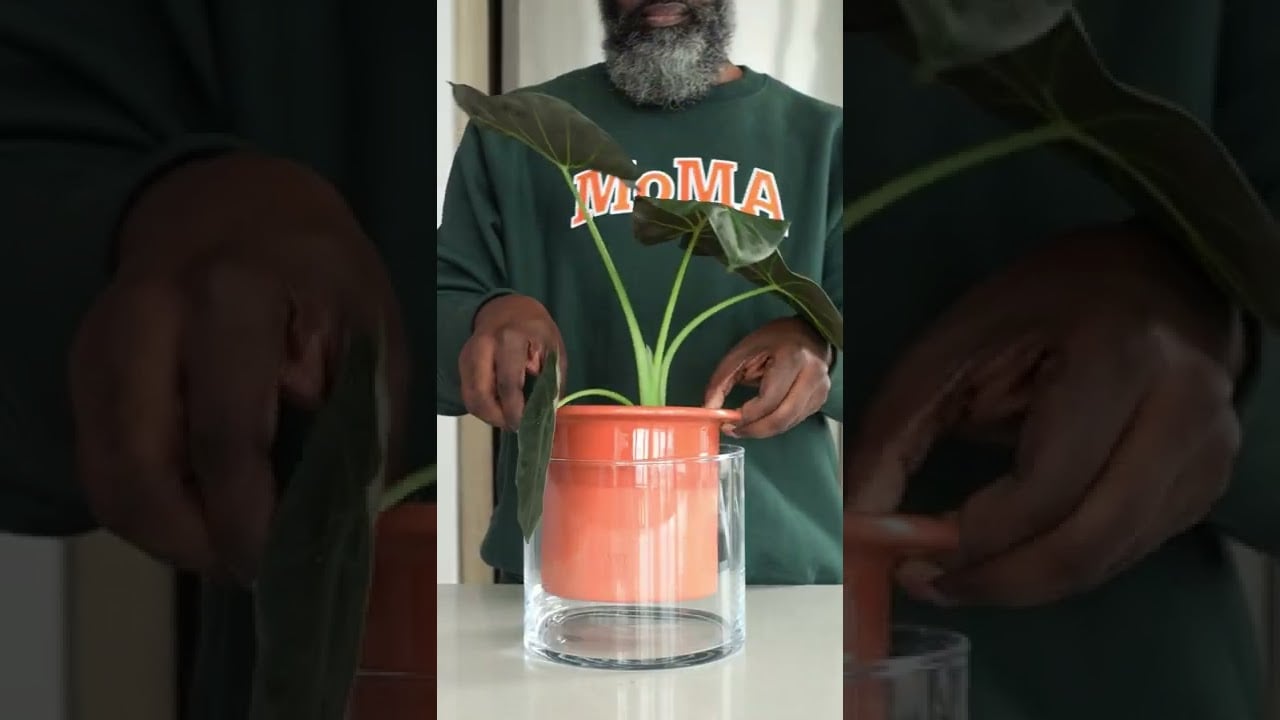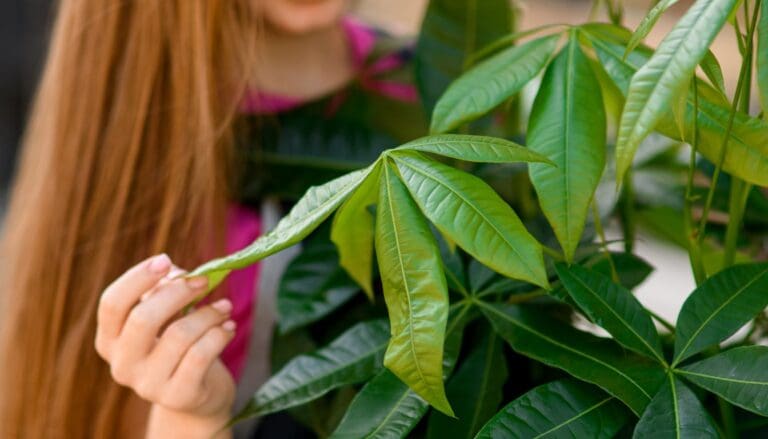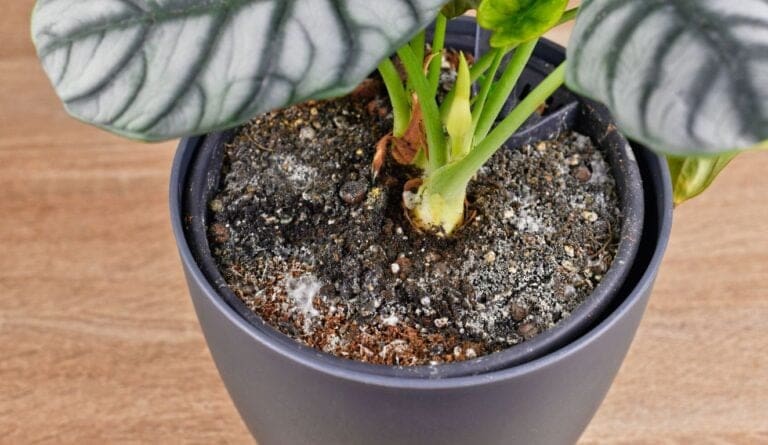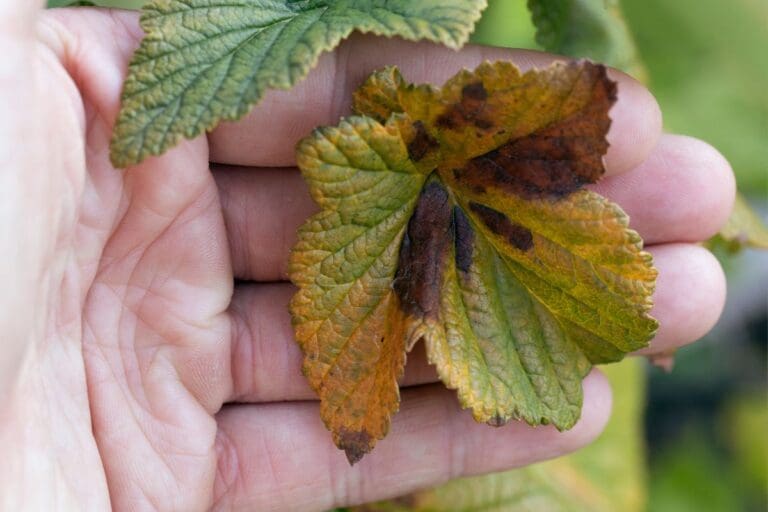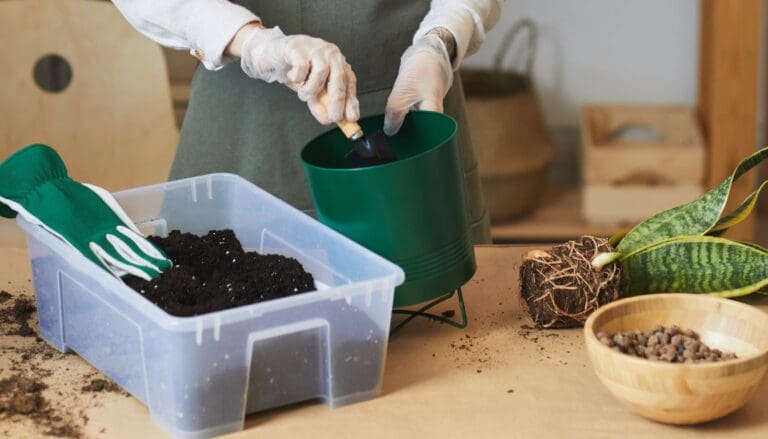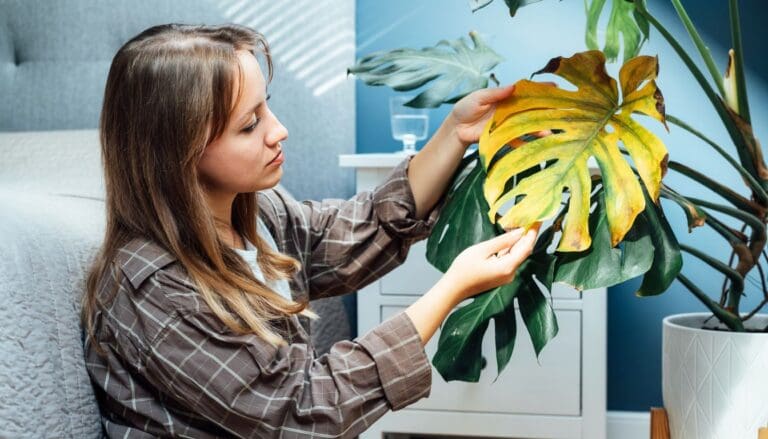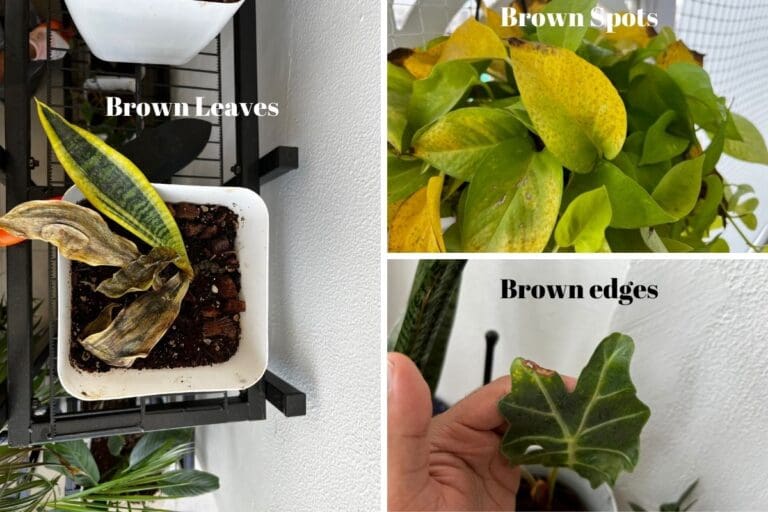10 Plant Watering Tricks for Super Dry Homes in Summer
Summer always seems to make my home feel extra dry, and honestly, keeping my plants happy gets a bit tricky. The air just sucks the moisture out of the soil so fast—sometimes it feels like my plants are thirsty all the time!
I want to share the best ways I’ve found to help my plants get the water they need, even during the hottest months. These tricks have really helped me out, and I’m pretty sure they’ll make plant care less stressful for anyone dealing with dry indoor air.
Please note: Simplify Plants is reader-supported. As an Amazon Associate, I earn from qualifying purchases made by our readers with no extra cost added to you all! Some links in the post are affiliate links and I get a commission from purchases made through links in the post.
1) Use self-watering pots with a reservoir
I’m a fan of self-watering pots, especially in the summer. These pots have a built-in reservoir that holds extra water, so my plants get a steady supply even when the air is bone dry.
When I fill up the reservoir, the roots can pull up water as they need it. This means I don’t have to stress about the soil drying out too quickly.
It also helps prevent overwatering since the plant basically decides for itself how much to drink. I check the reservoir every few days and top it off if it’s getting low.
Self-watering pots are everywhere these days—garden stores, online, you name it. I’ve got tiny ones for my herbs and bigger ones for the leafy plants.
One thing I try not to do is let the reservoir go totally empty, or the system just doesn’t work. If I’m going away for a few days, I always make sure to fill it up before I leave.
Honestly, these pots save me time and a bit of worry. My plants look happier when they can drink at their own pace, and I don’t have to hover over them all summer.
2) Apply mulch to soil surface to retain moisture
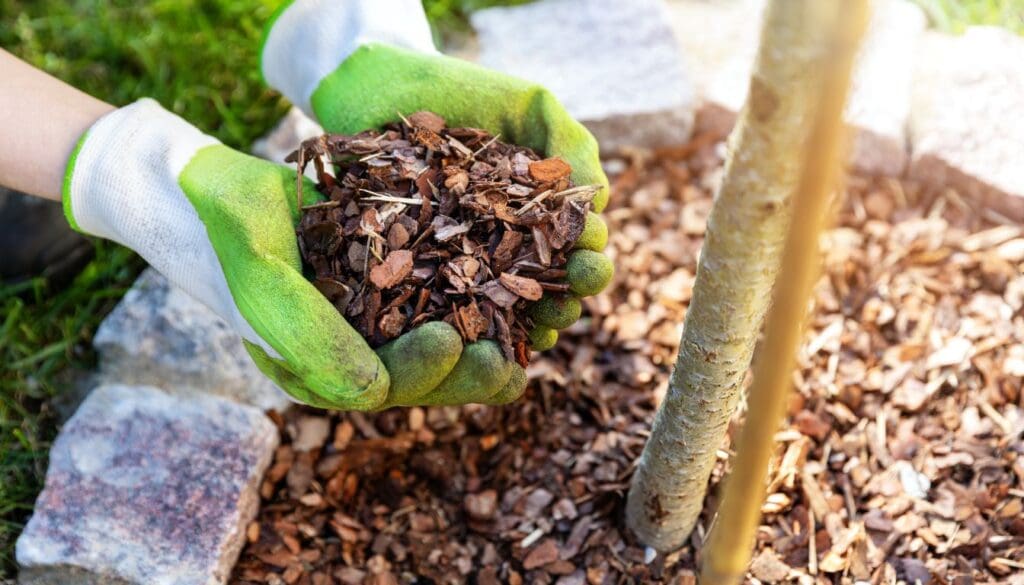
I’ve started using mulch to help my plants when it’s dry out. Mulch is just a layer of stuff—bark, straw, leaves, even shredded newspaper—on top of the soil.
Mulch keeps soil cool and slows down water evaporation. The soil stays damp longer, so I’m not watering constantly.
It’s super easy to do. I just put down a 1-2 inch layer, but I leave a little gap around the stem so nothing gets soggy or rots.
You don’t have to buy anything special—sometimes I just use dried leaves from the yard. Mulch even helps with weeds, since less light gets to the soil.
Another bonus: as organic mulch breaks down, it adds nutrients to the soil. I swear my plants grow better with mulch than without.
In especially dry homes, mulch acts like a little blanket, protecting the soil from harsh sun and dry indoor air. It’s such a simple step, but it really makes a difference.
3) Water plants early morning before sunrise
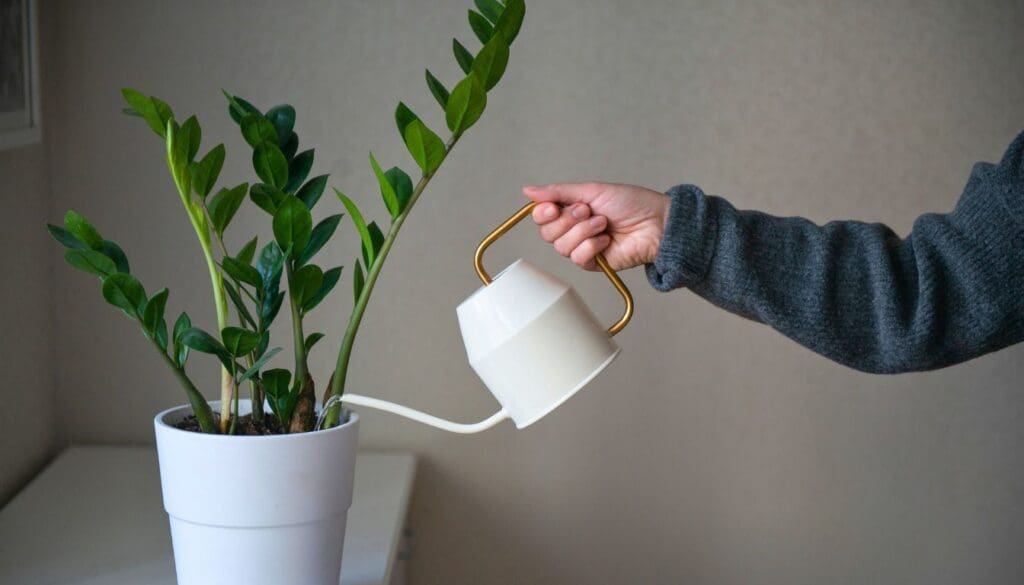
I’ve noticed that watering my plants early in the morning makes a big difference, especially when it’s dry. The air is cooler, and the sun hasn’t had a chance to bake everything yet.
When I water before sunrise, the soil gets time to soak it all up. The roots can take in water more slowly, which just seems better for growth.
If I wait until later, most of the water just vanishes into the air. I want as much as possible to reach the roots.
Morning watering also keeps my plants from getting scorched. Water droplets on the leaves under harsh sun can actually burn them—who knew?
It’s easier to remember if I do it at the same time every day, and my plants seem to appreciate the routine. If I miss the early window, I avoid watering during the hottest part of the day.
I’ve seen my plants perk up and look more vibrant with this trick. Plus, early watering helps prevent mold and pests, since the leaves dry off quickly in the morning light.
4) Place humidity trays near plants
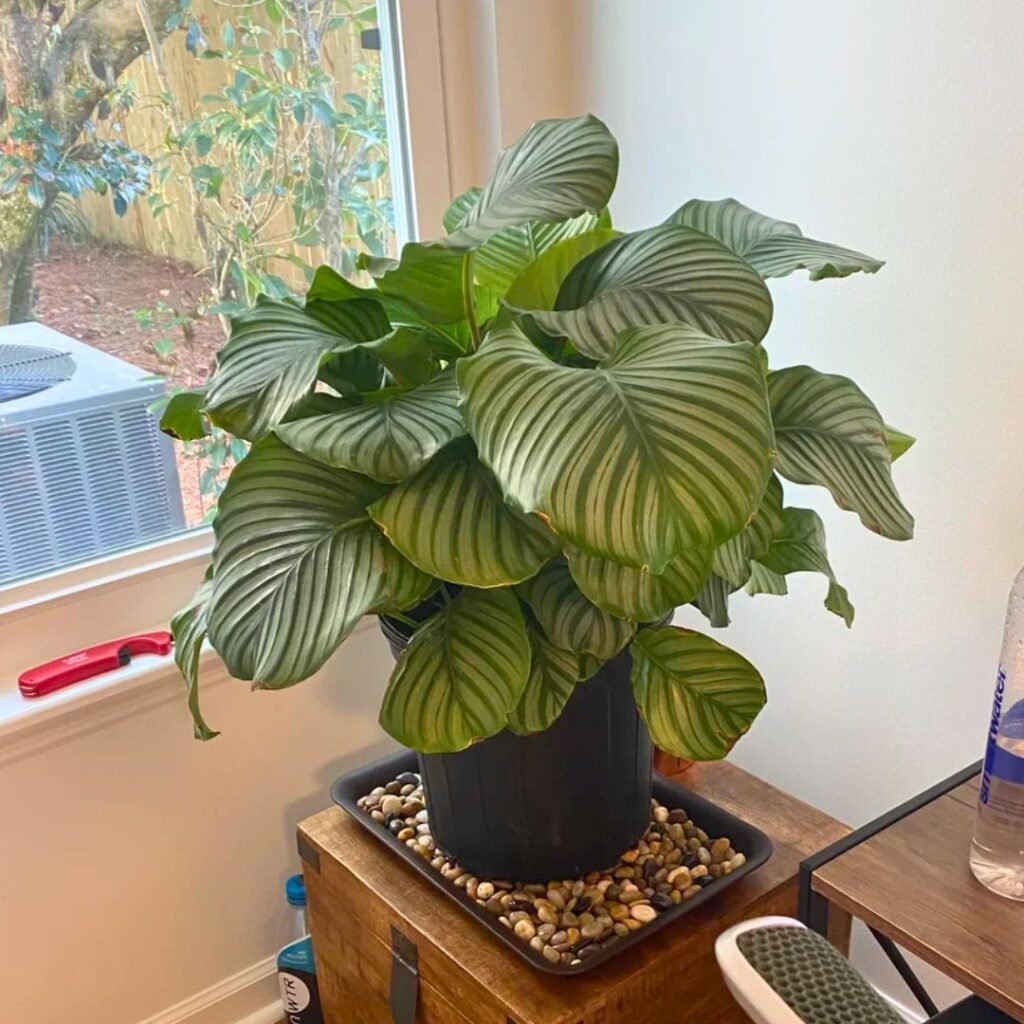
I use humidity trays to keep my plants happy when my home feels desert-dry. It’s such a simple fix.
All I do is grab a shallow tray, fill it with pebbles, and pour in water just below the top of the stones. Then I set my plant pot right on top, making sure the bottom isn’t sitting in water.
The water slowly evaporates and bumps up the humidity around my plants. I check the trays every couple of days and refill when needed.
I find this trick works especially well for ferns, palms, and other humidity-lovers. Plus, the trays look nice and keep my shelves from getting water rings.
Humidity trays are one of those easy things that actually make a difference. No fancy gadgets—just pebbles, water, and a little attention.
5) Mist leaves regularly with a spray bottle
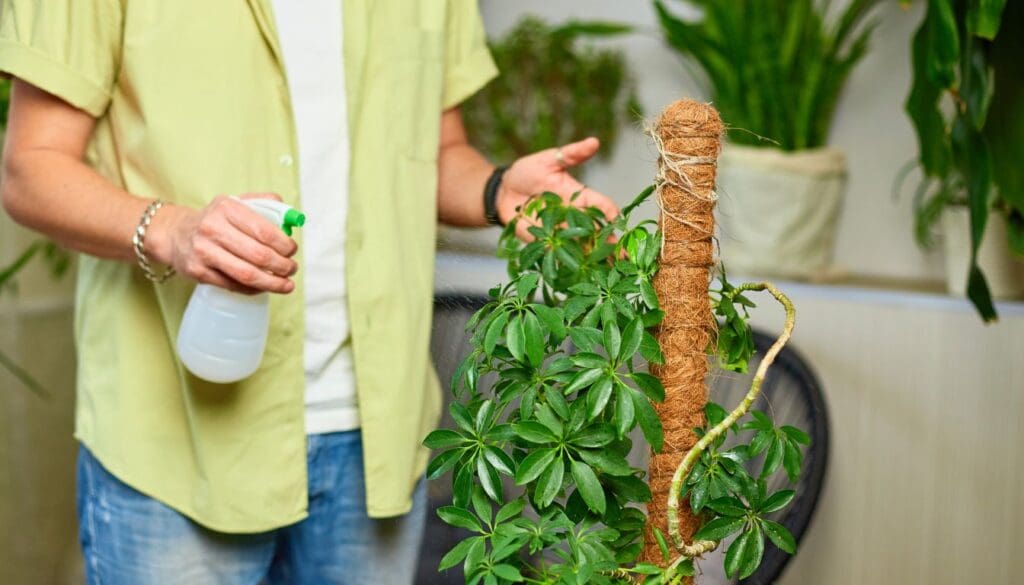
I’ve found that misting my plant leaves helps them deal with the dry air. Summer just seems to suck the moisture right out, but misting gives their leaves a quick humidity boost.
I use a clean spray bottle with room-temp water and gently mist the tops and undersides of the leaves. I try not to drench them—just a light spray is enough.
I mist once a day if it feels really dry inside. On milder days, every other day works fine.
I skip misting plants with fuzzy leaves, like African violets. Those leaves don’t like water sitting on them.
If I see water droplets hanging around too long, I cut back on misting, since too much can cause mold or fungus. Misting is quick and makes my plants look a bit perkier.
Sometimes I’ll wipe the leaves with a soft cloth after misting to get rid of dust. Clean leaves just seem to soak up more light and look healthier.
6) Group plants together to create a microclimate
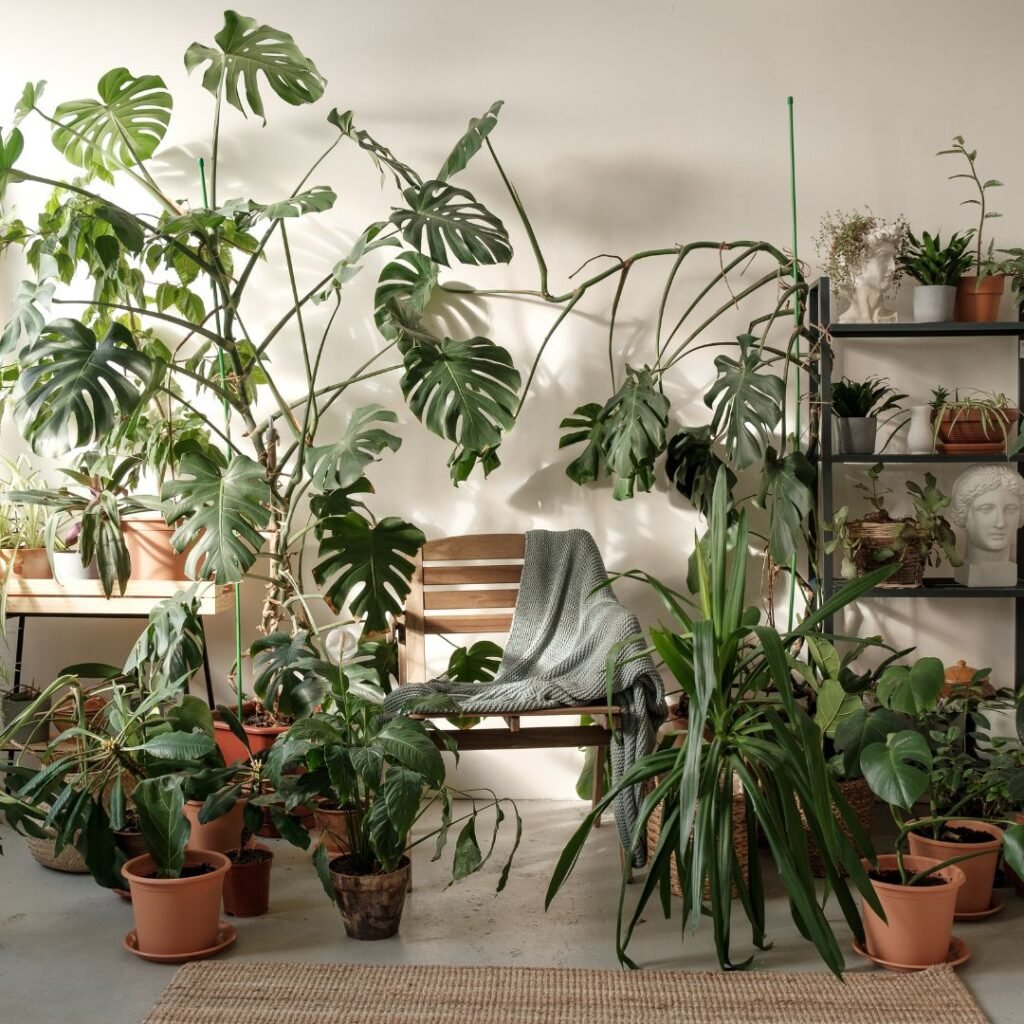
Grouping my plants together is a trick I use all summer. When plants are close, they create a tiny “microclimate” with more moisture in the air. It’s almost like they help each other out.
I usually tuck smaller plants under or beside my bigger ones. The big leaves give some shade and extra humidity, which means I don’t have to water as often.
The soil dries out slower when plants are clustered. Their leaves trap humidity, so it doesn’t just disappear into the room.
Honestly, I like the way grouped plants look—my place feels like a mini jungle. Plus, I can rearrange them if one needs more sun or shade.
Whenever I get a new plant, I see if there’s space in my little “plant cluster.” It’s a simple way to give them a better shot at surviving dry air.
7) Use a moisture meter to avoid overwatering

A moisture meter makes watering so much less confusing. I just stick it into the soil and get a quick read on whether it’s wet, damp, or dry.
Sometimes the top of the soil looks dry, but deeper down it’s fine. The meter stops me from watering too much and avoids root rot.
I just poke the probe in near the roots and check the reading. If it says the soil’s still moist, I wait a bit longer to water.
I don’t water on a set schedule anymore—only when the meter says the plant actually needs it. That’s saved a few plants from my old habit of overwatering.
Moisture meters are easy to find and not expensive. I keep mine handy and check all my plants in one go.
If you’re tired of guessing, a moisture meter is a must-have for plant care in dry homes.
8) Add hydrogel crystals to soil for water retention
Hydrogel crystals are a neat trick for keeping plants hydrated. These little crystals soak up water and release it slowly back into the soil.
I mix the crystals into the potting soil before planting. I’m careful not to use too many—always check the package instructions.
When I water, the crystals swell up and store extra moisture. On hot days, they slowly give water back to the roots, so I don’t need to water as often.
I use hydrogels mostly for hanging baskets or small pots, since those dry out fastest. It’s a lifesaver when I’m busy or just forgetful.
Even with hydrogels, I still check the soil by hand. If it feels dry, I give it a drink. Hydrogel crystals just make summer plant care a whole lot easier.
9) Choose drought-resistant plants like succulents
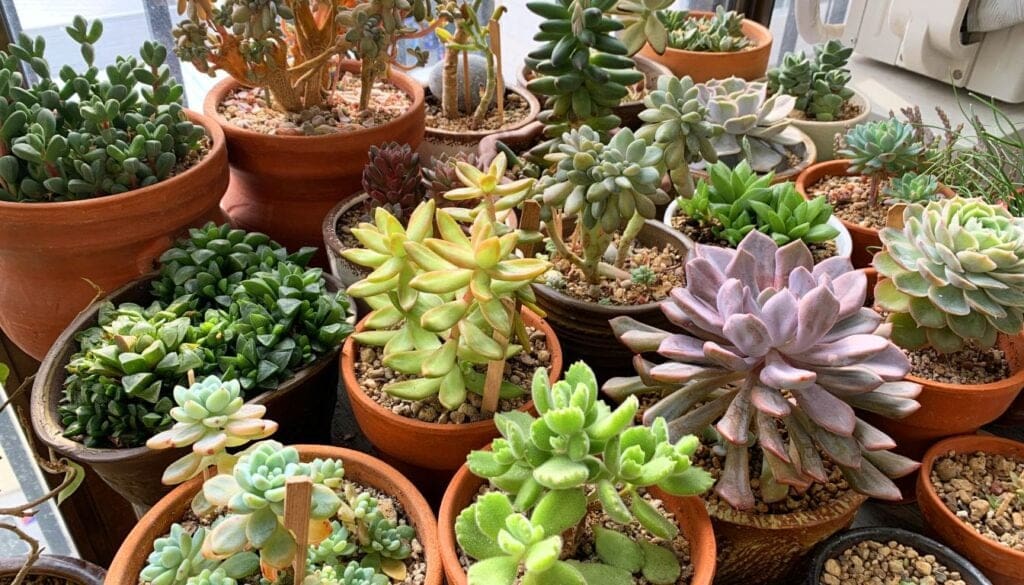
When my place gets super dry in the summer, I honestly just want plants that can handle it. Succulents are a top choice for me because they store water in their leaves. That means less watering, less fuss, and they can survive longer without attention.
Plants like aloe, jade, and snake plant do especially well in dry air. They don’t wilt as fast as some of the fussier houseplants.
I don’t have to worry as much when I forget to water them for a few days. It’s honestly a relief.
Succulents come in so many shapes and sizes, I can always find one that fits the little nooks and shelves around my apartment. Their thick, waxy leaves help them hold onto water for longer.
I like using small pots for them in my living room. They don’t hog space, and I just love their look—lots of neat colors and textures.
If you want easy-care plants, really, start with succulents. They save water, save time, and just make life a little easier during those hot, dry months.
10) Install drip irrigation for slow, deep watering
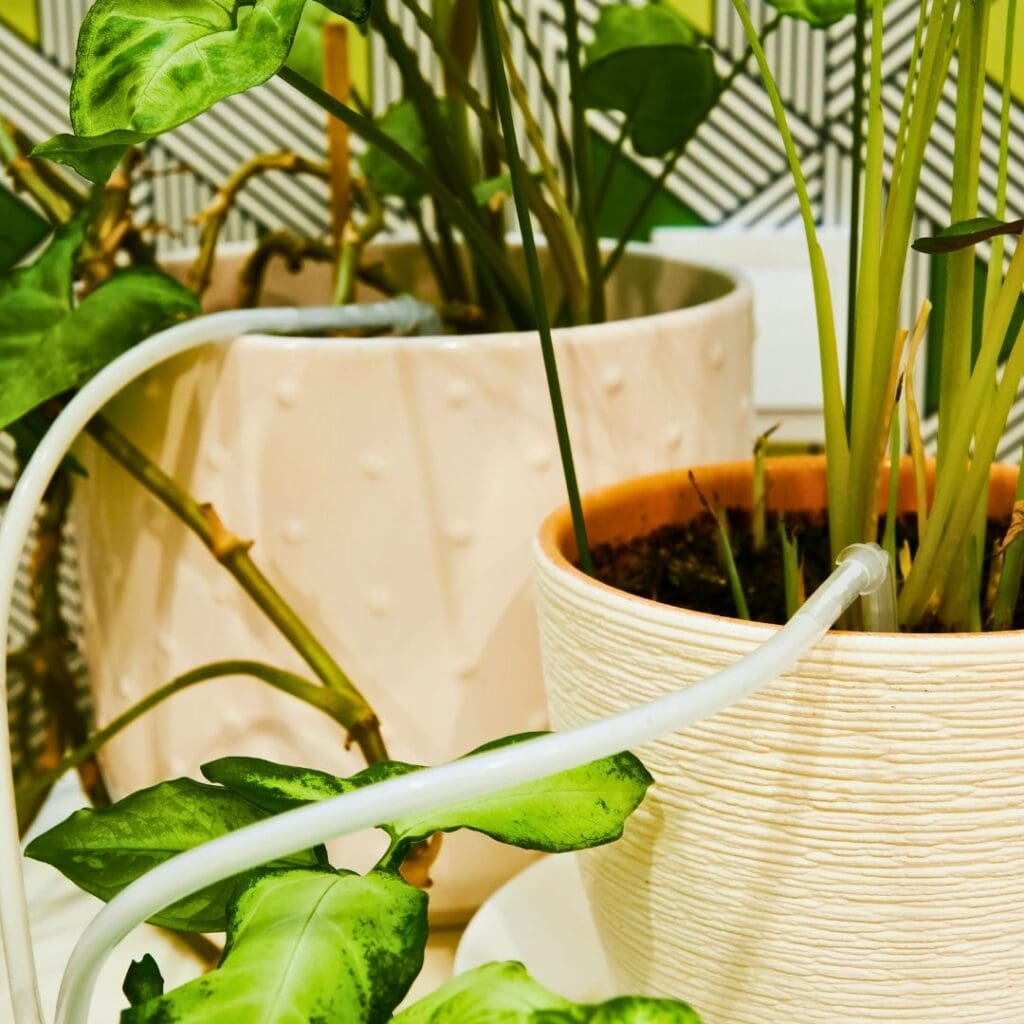
I’ve found that drip irrigation is a game changer. It gets water right to the roots, without any waste.
This system’s gentle, keeps soil moist even when my place feels like a desert. Setting it up wasn’t nearly as tough as I expected.
I just grabbed a kit from the garden store, a timer, and a few basic tools. Placing the tubing around my pots or beds and hooking it up to the water supply was actually kind of satisfying.
The best part is the slow, steady flow. Water drips out a bit at a time, soaking deep into the soil instead of running off.
Roots grow stronger, and plants don’t dry out so quickly. Plus, I water less often and don’t have to stress if I forget a day.
I like being able to adjust the water for each plant. Some are thirstier than others, and this way, I can actually give them what they need.
I’ve noticed less runoff and my leaves aren’t getting soggy anymore. Water just goes where it’s supposed to.
If you want to make watering easier, try drip irrigation. It’s honestly great if you’re busy or just want to simplify plant care.
My plants look healthier and happier since I made the switch. Wish I’d tried it sooner, honestly.
Understanding Plant Watering Challenges in Dry Homes
I’ve noticed plants really struggle when the air inside gets dry, especially in summer. Water just disappears from soil and leaves way faster than I’d like.
How Summer Dryness Impacts Indoor Plants
When my home heats up and dries out, the soil dries up in no time. Low humidity means water evaporates quickly from leaves, leaving plants thirsty.
Some plants, like ferns and calatheas, are just not built for that. They’re usually the first to look sad.
Dry indoor air means I have to water more often. Sometimes I feel like I’m chasing the dryness and losing.
I try to keep plants away from air conditioners and heaters. Moving air just speeds up the drying.
Grouping plants together or using a humidity tray sometimes helps slow down the water loss.
Common Signs of Underwatered Plants
I keep an eye out for wilting. Wilted leaves are usually the first thing I notice.
Leaves can droop, curl at the tips, or just look thin and floppy. Brown or crispy edges are another red flag.
Sometimes, the lower leaves turn yellow or even drop off. If the soil feels dusty or pulls away from the pot, it’s definitely too dry.
Regular checking helps a lot. Just poking my finger into the soil tells me if it’s time to water.
Fixing dryness quickly keeps my plants healthy and green. I wish I’d learned that sooner.
Choosing the Right Tools and Materials
Honestly, having the right tools makes plant care in dry summer air way easier. The right soil and gear just save so much hassle.
Selecting Watering Cans and Misters
I always pick a watering can with a long, narrow spout. It lets me water right at the base, so leaves stay dry and I don’t lose water to evaporation.
For small plants, a 1-liter can is perfect—doesn’t get too heavy, and it’s easy to aim.
If I want to give plants a humidity boost, I use a fine-mist spray bottle. It’s great for ferns and orchids.
I avoid using old cleaning bottles because, well, chemicals. I clean my mister with warm water pretty often to keep it from getting gross.
Here’s a quick guide:
| Tool | Best For | Tips |
|---|---|---|
| Watering can | Daily deep watering | Choose a long spout |
| Spray mister | Humidity-loving plants | Use fine mist setting |
Using the Best Soil Mix for Moisture Retention
I like soil that holds water but doesn’t get swampy. Mixing potting soil with coconut coir or peat moss helps the soil hold onto moisture longer.
For drainage, I toss in a bit of perlite or vermiculite. If I’m using clay or unglazed pots, I’ve noticed the soil dries out even faster.
I check the soil daily and water when the top inch feels dry. Mulching with pebbles or bark chips on top helps a ton to trap moisture in summer.
Simple Soil Mix Recipe:
- 2 parts potting soil
- 1 part coconut coir or peat moss
- 1 part perlite or vermiculite
This mix keeps my plants hydrated but not soggy. It’s a nice balance.
Frequently Asked Questions
I rely on simple tools and little tricks to keep my plants healthy in dry summer conditions. Maintaining the right moisture level is so much easier when I use solutions that fit my lifestyle and travel plans.
What are some effective DIY self-watering systems for plants?
I’ve found that using a water-filled wine bottle stuck upside down in the soil works surprisingly well. I’ve also made wicks from cotton cloth—one end in water, the other in the soil.
Can you suggest any slow release watering methods for dry indoor conditions?
I like self-watering pots with built-in reservoirs for a steady supply. Gel watering crystals mixed into the soil are another trick—they release water slowly as needed.
How can automatic watering tools like Blumat stakes help during extended vacations?
If I’m gone for a while, Blumat stakes are a lifesaver. They pull water from a nearby container into the soil, so my plants never go dry, even if I’m away for days.
What’s the best way to keep houseplants hydrated for multi-week trips?
For longer trips, I put plants in self-watering pots or group them over trays filled with water and pebbles. Covering the soil with mulch to lock in moisture and moving pots out of direct sun helps too.
Are there any innovative tricks to ensure plants get enough water while I’m away for a month?
Before I travel, I water early in the morning for deep hydration. Sometimes I set up humidity trays and mist the leaves. Mixing a few of these tricks together keeps my houseplants happy for weeks.
What should I consider when setting up a watering routine for a particularly dry home?
In a dry home, I usually check the soil moisture more often than I would elsewhere. It’s honestly a bit of a hassle, but it’s worth it.
I try to water before the hottest part of the day—otherwise, it feels like the water just vanishes. Mulch helps slow down how quickly the soil dries out.
Sometimes I’ll set out humidity trays here and there, just to get a bit more moisture in the air. It’s not perfect, but every little bit helps.
Recommended Garden Supplies
| Product Image | Our Recommended Gardening Supplies | Check Offers! |
|---|---|---|
Top Top
Top
Top
Top
Top
Top
Top
Top | rePotme Houseplant and Tropical Classic Potting Soil Mix | Check Offer On Amazon |
 Top
Top
Top
Top
Top
Top
Top
Top | Espoma Organic Indoor Plant Food | Check Offer On Amazon |
 Top
Top
Top
Top
Top
Top
Top
Top | GooingTop LED Grow Light 6000K Full Spectrum Clip Plant Growing Lamp | Check Offer On Amazon |
 Top
Top
Top
Top
Top
Top
Top
Top | Soil Moisture Meter | Check Offer On Amazon |
 Top
Top
Top
Top
Top
Top
Top
Top | Govee Hygrometer Thermometer, Bluetooth Enabled! | Check Offer On Amazon |
 Top
Top | LEVOIT Humidifiers for Large Room(Best For Plants) | Check Offer On Amazon |
 Top
Top
Top
Top
Top
Top
Top
Top | Upgraded DIY Automatic Drip Irrigation Kit, 15 Potted Houseplants Support | Check Offer On Amazon |
 Top
Top
Top
Top
Top
Top
Top
Top | Stainless Steel Heavy Duty Gardening Tool Set | Check Offer On Amazon |
 Top
Top
Top
Top
Top
Top
Top
Top | Bonide Insecticidal Soap | Check Offer On Amazon |
 Top
Top
Top
Top
Top
Top
Top
Top | Bonide 32 oz Spray Neem Oil for Organic Gardening | Check Offer On Amazon |
 Top
Top
Top
Top
Top
Top
Top
Top | Garden Safe Fungicide | Check Offer On Amazon |

